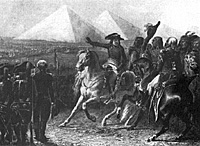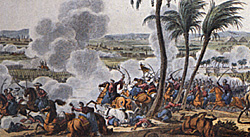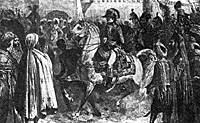 Napoleon Conquers Middle Egypt
Napoleon Conquers Middle Egypt
On 21 July, the two armies met again near the village of Embabeh, just across the Nile River from Cairo. Estimates of Mameluke strength vary, but Murad Bey commanded approximately 6,000 Mameluke horsemen and about 10,000 to 15,000 peasant levies.
Romantic legend has Napoleon addressing his troops "in the shadows of the pyramids" before the battle for Cairo. In fact, the pyramids were miles away, although most artists insist on including them in their portrayals of the battle of that name. (Anne S. K. Brown Military Collection, Brown University Library).
Meanwhile, stranded on the other side of the river, Ibrahim Bey's larger army acted merely as an enthusiastic cheering section, until dust and smoke obscured the looming disaster from their view.
As at Shubra Khit, Bonaparte used large divisional squares to repel the Mameluke cavalry advance. However, at Embabeh the squares were lengthened into rectangles to increase firepower, and each division placed a demi-brigade at the front and rear of the rectangle, while the third
demi-brigade or dismounted dragoons formed the shorter sides. Napoleon also ordered the bands to play the Revolutionary anthem La Marseillaise, of which a Captain Vertray recorded that, "This marvelous song incites the soldiers' courage, inflames their patriotism and makes
them realize that the time for complaints has passed and that "their job is to be victorious."
General Desaix's square deployed on the far right, closest to the desert, supported to the left by Reynier, while Bon and Vial were on the Nile flank, supported by the guns of the French flotilla. Dugua's square, which sheltered Bonaparte and his staff, was in the center. Desaix also sent a detachment to occupy a nearby village, providing an extension of the French right, where his men would provide fire from the rooftops of the buildings.
In the late afternoon, the Mamelukes, mounted on splendid Arabian horses, charged on the
French right. One eye-witness, Baron Desvernois, related this account of the Mamelukes:
 In reality, the pyramids were obscured from sight, and the disciplined French infantry squares did not need their inspration to stand firm against the thousands of mameluke horsemen in what became known as the Battle of the Pyramids (Anne SK Brown Military Collection, Brown University Library.
In reality, the pyramids were obscured from sight, and the disciplined French infantry squares did not need their inspration to stand firm against the thousands of mameluke horsemen in what became known as the Battle of the Pyramids (Anne SK Brown Military Collection, Brown University Library.
The French victory was decisive.
French casualties amounted to 29
dead and approximately 200 wounded
...the Mamelukes lost thousands.
"They wore very beautiful costumes, egret feathers on the turbans, some wore gilded helmets. They were armed with spears, sabers and lances, battle axes and daggers and each wore three sets of pistols. Their appearance, in its novelty and richness, left a vivid impression on our soldiers. From then on, their thoughts were on booty."
Once again, the Mamelukes were no match for French discipline, tightly closed ranks, massed musketry and artillery. Captain Vertray described the action from inside the squares:
"We fired so calmly that no cartridge was wasted, waiting for the very moment when their riders were about to break into our squares. The number of bodies around our square grew rapidly, the clothes of the wounded and dead Mamelukes burned like tinder."
The one-sided battle lasted less than two hours. While Desaix, Reynier and Dugua repulsed the Mameluke cavalry, Bon's division took the village of Embabeh. As the garrison's retreat was blocked, many attempted to swim across the Nile to join Ibrahim Bey but drowned.
The French victory was decisive. French casualties amounted to 29 dead and approximately 200 wounded (much of the losses reputedly due to friendly fire between supporting squares), while the Mamelukes lost thousands.
Battle of the Pyramids Maps (very slow: 251K)
Both Murad Bey and Ibrahim Bey fled south, and Cairo surrendered to the French. Even before the battle had completely ended, the French began pilfering the Mameluke corpses of their gold coins and elaborately decorated weapons. Because Mamelukes carried their wealth into battle with them, their abandoned baggage provided the French with a rich booty.
The victory was immortalized in the European popular mind as the Battle of the Pyramids, even though the pyramids were miles away, closer to the horizon than the battle site. To rally his troops before the Mameluke onslaught, Bonaparte reputedly gestured toward the celebrated monuments of antiquity and said, "Soldiers! Forty centuries of history look down on you."
...just nine days after the
capture of Cairo, the French
suffered a disaster that would isolate
Bonaparte and his expeditionary army...
The reference to the pyramids gave the victory an added cachet of glamour, and captured the flavor of eastern exoticism.
On 24 July, Bonaparte entered Cairo and set up headquarters in a house on Esbekiya Square. Having conquered Lower Egypt and now Middle Egypt, he dispatched Desaix to pursue Murad Bey who had fled to Upper Egypt, and then began to make plans for colonization and the introduction of European amenities into a city that the French considered primitive at best.
The large population of Cairo was initially subdued and fearful of the French, but the French position in Egypt was hardly secure. For, on 2 August, just nine
days after the capture of Cairo, the French suffered a disaster that would isolate
Bonaparte and his expeditionary army, changing the course of French plans for Egypt.
Melanie Sue Byrd earned a doctorate in European History specializing in the French Revolution and the Napoleonic era from Florida State University in 1992. She currently teaches
European History at Valdosta State University in Valdosta, Georgia. Her series on women's fashion appeared in Napoleon #4-6. Matt DeLaMater is the Editor of Napoleon Journal and Yves Martin is our Paris correspondent, providing translations of key sources from the French archives.
More Napoleon in Egypt
 After the Battle of the Pyramids, Napoleon took Cairo. The Mamelukes were still a potent force, however, and the French situation would change for the worse when the British
caught their fleet at Aboukir Bay. (Anne S. K. Brown Military Collection, Brown University Library).
After the Battle of the Pyramids, Napoleon took Cairo. The Mamelukes were still a potent force, however, and the French situation would change for the worse when the British
caught their fleet at Aboukir Bay. (Anne S. K. Brown Military Collection, Brown University Library).
Napoleon in Egypt: Introduction
Napoleon in Egypt: Why Egypt?
Napoleon in Egypt: Alliance and Assembly
Napoleon in Egypt: Expedition Commences
Napoleon in Egypt: Expedition Arrives
Napoleon in Egypt: Battle of the Pyramids
Napoleon in Egypt: French Artillery Strength
Napoleon in Egypt: French Dragoons Uniform Guide
Napoleon in Egypt: French Light Cavalry Uniform Guide
Napoleon in Egypt: French Army of Orient Order of Battle (text: fast 10K)
Napoleon in Egypt: French Army of Orient Order of Battle (graphics: very slow: 314K)
Cover Illustration: Napoleon in Egypt
Back to Table of Contents -- Napoleon #13
Back to Napoleon List of Issues
Back to MagWeb Master Magazine List
© Copyright 1998 by Napoleon LLC.
This article appears in MagWeb (Magazine Web) on the Internet World Wide Web.
The full text and graphics from other military history magazines and gaming magazines are available at http://www.magweb.com
Order Napoleon magazine direct